| |
|
|
|
|
English Family Quick Links
|
|
|
|

|
|
|
|
|
Family 17: Byerley Turk Mare
 |
VIEW DESCENT CHART
The first entry for this family in the General Stud Book is for the Wharton Mare, by the Carlisle Turk. The pedigree given for her female line is that she was out of a mare by the Bald Galloway, who was out of a mare by the Byerley Turk. The GSB notes the Bald Galloway cross "...is probably incorrect, but it is given in all the pedigrees." However, it is not given in the entry of her daughter, Old Lady, a few pages earlier, nor is it included in a mid-eighteenth century portrait of her son, the Carlisle Gelding (also known as Buckhunter). In the Carlisle Gelding portrait, it states his dam "...was got by a Turk of the said late Earl Carlisle's, His Grand-Dam was a Daughter of the Byerley Turk."
The GSB also says the Wharton Mare was bred by Lord Carlisle. From the birth date of the Carlisle Gelding, 1713, and her last recorded foal, Squirrel in 1723, it seems the Wharton Mare probably was born around 1700, at the earliest; her dam's sire, the Byerley Turk, is recorded as participating as a charger in the Battle of the Boyne in 1690, and was at the stud up to at least 1696. In 1700, Lord Carlisle was Charles Howard (1669 - 1738), the 3rd Earl of Carlisle, whose name figures prominently in the racing calendars of the period. The family estate was Naworth Castle, Cumberland, and a new, "modern" structure, Castle Howard (initially designed by Vanbrugh), near York, was begun on property belonging to his grandmother, around 1699, and continued under construction beyond the 3rd Earl's death.
The Carlisle Gelding was first raced by his breeder, and then later sold to Sir Edward O'Brien, who continued to run him beyond age 14. Both he and his sister, Old Lady, were bred by Lord Carlisle, according to the GSB. The Wharton mare's last two foals, a filly by the Carlisle Barb and her brother, Squirrel, are listed as being bred by Colonel [Charles] Howard, the second son of Lord Carlisle.
The breeders of Old Lady's foals are not listed in the GSB, so we can not tell where she was located. We know one daughter, Worlock's (incorrectly spelled "Warlock" in the GSB) Galloway, fell into the hands of -- or was bred by - -Captain William Worlock of North Yorkshire. Her second daughter, a mare by Bartlett's Childers, was apparently owned by George Walpole (3rd) Earl of Orford (grandson of the Prime Minister Robert Walpole) of Norfolk, during her time as a broodmare, since he is attributed as the breeder of all her foals in the GSB. The Bartlett's Childers mare produced a vigorous family that continued through the next century.
Captain Worlock's chestnut Galloway, was obtained from Captain William Worlock of Sunythwatt, by Cuthbert Routh, who bred horses at Dinsdale, North Yorkshire, and later Snape, near Bedale in North Yorkshire, in 1732. She had run under the name of Cloudy, and had won the first two heats of a 10 guineas plate race at Sedgefield, Co. Durham, in February of 1732. In 1733 she was put to Young Greyhound, owned by Richard Harrison, and the following year produced a filly for Routh. Worlock's Galloway went on to produce a number of other foals for Routh: her daughter Blackeyes, by Portmore's Crab, won several races and then went on to produce a number of foals with descedants who were successful through several generations. Worlock's Galloway's last foal, a chestnut filly of 1745, by Cottingham, was the dam of several successful racehorses, and it is through her that the family continued to modern times.
|
Byerley Turk Mare's
Known Produce:
The Wharton Mare by the Carlisle Turk. Dam of
c. Buckhunter (Carlisle Gelding) (1913) by the Bald Galloway
f. Old Lady by the Bald Galloway. Dam of
f. Warlock's Galloway (Cloudy) (1724) by (Lister) Snake.
f. Mare by Bartlett's Childers.
f. Mare by Darley Arabian.
f. Mare (1722) by Carlise's Barb, also called a foreign horse of Sir C.W. Strickland, probably Strickland Turk.
c. Squirrel (1723) by Carlise's Barb, also called a foreign horse of Sir C.W. Strickland, probably Strickland Turk.
|
|
|
FAMILY #17 NOTABLE DESCENDANTS
|
|
Family #17 Oaks Winners
|
|
|
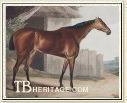 |
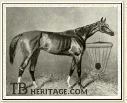 |
|
Meteora
|
Regalia
|
|
1805 METEORA b.f. 1802
(Meteor - Maid of All Work) |
1865 REGALIA ch.f. 1862
(Stockwell - The Gem) |
| |
|
|
Family #17 St. Leger Winners
|
|
| | 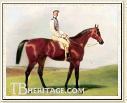 |
|
Saucebox
|
|
1785 COWSLIP b.f. 1782
(Highflyer - Sister to Tandem) |
1804 SANCHO b.c. 1801
(Don Quixote - Sister to Cowslip) |
1855 SAUCEBOX b.c. 1852
(St. Lawrence - Priscilla Tomboy) |
|
|
Family #17 Other Family Members
|
 |
|
Carlisle Gelding
|
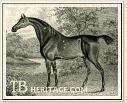 |
|
Citizen
|
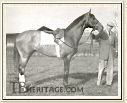 |
|
Decidedly
|
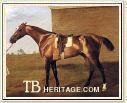 |
|
Firetail
|
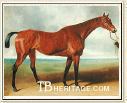 |
|
Fleur de Lis
|
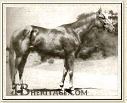 |
|
Gallorette
|
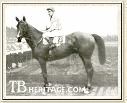 |
|
Johnstown
|
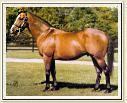 |
Lyphard
Image Courtesy Tony Leonard
|
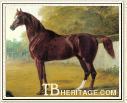 |
|
Pantaloon
|
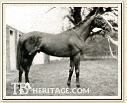 |
|
Omaha
|
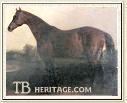 |
|
Sovereign
|
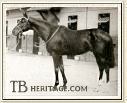 |
|
Tiepoletto
|
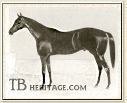 |
|
Yattendon
|
|
Carlisle Gelding (Buckhunter) ch. g. 1713
(Bald Galloway - The Wharton Mare)
Famous early 18th century racehorse known for his durability, endurance and weight-carrying ability. Gelded young, "...his excessive Heat & Spirit, in his Youth rendering him almost Ungovernable." He won a number of King's Plates and matches at Newmarket; at age 14 he was sold to Sir Edward O'Brien, for whom he continued to race and win, both in Wales and all over England, finally lamed and destroyed. It is from his sister, Old Lady, that Family 17 descends. |
Citizen b.c. 1785
(Pacolet - Princess)
Ran for six years, mostly two and four mile heats, primarily in the north of England, his most impressive wins being the Prince of Wales' 100 guineas race at Conway in 1791, and a 500 guineas match against Magnolia, by Highflyer, in 1792. Sent to the West Indies, imported from there into North Carolina, at age 18, in 1803 by General Stephen Carney. He was described as having a "...game, Arabian look and carriage." In the six years up to his death, he covered over 500 mares in the U.S. Son Pacolet was a good racehorse and sire. Citizen was a top broodmare sire, getting the dams of Sir Charles (Sir Archy's most successful son) and his top racing sister Janette; of Stockholder (most popular sire of early 19th century in Tennessee) and his sister the racemare Rarity; of Marion (sire of Maria West), and many others. |
Decidedly gr. c. 1959
(Determine - Gloire Fille)
Although he won the Kentucky Derby decisively, he was not a reliable two or three year old, winning 4 of his 20 starts during those years, and placing second five times. He continued at ages 4 and 5 to win the Monmouth Handicap and some other races, but was not counted among the leaders in either year. Not a success at stud, his best foals were the two long-running handicappers, Wardlaw and Cat's Memory (195 starts). His fourth dam was a sister to Gallorette and half-sister to Flambino, dam of Omaha and Flares. |
Firetail b.c. 1769
(Squirrel - Jet)
Good mid-18th century racehorse ran for four years, age 3 to 6, primary in matches, stakes, and sweeps at Newmarket. |
Fleur de Lis b.f. 1822
(Bourbon - Lady Rachel)
Spectacular race mare of the 18th century, ran for seven years; she won all her races at age 3 (not entered in the Oaks or Derby), except the St. Leger, where she was thrown down. Unbeaten at age 4, she won the Doncaster Cup and the Doncaster Stakes, and a number of other races, trouncing the best older horses of both sexes. Won the Doncaster Stakes again at age 5, among others. Additional wins during her long career included the 4 mile Oxford Cup (1828), the Oatlands (1828), Craven Stakes (1829), Goodwood Cup (1829, 1830), running second in the 1831 Goodwood Cup to Priam, in a "beautiful and most interesting race," after which she was retired, age 8. In the stud she produced Sovereign, by Emilius, who was sent to the U.S. where he became an influential sire, twice second on the leading sire lists, getting such horses as sisters Fanny Wells, an important American broodmare, and Prioress, who was shipped back to England and became the first American-bred horse to win the Cesarewitch. |
Gallorette ch. f. 1942
(Challenger II - Gallette)
Champion handicap mare in the U.S. at age 4, winning six of 18 starts against the best that year, including Stymie, to whom she lost and re-gained the lead to win in the Brooklyn Handicap; the Metropolitan Handicap (beating First Fiddle, Polynesian); the Bay Shore Handicap, and the Beldame Handicap under top weight. At 3 she she won the Pimlico and Delaware Oaks, among others; in all she won 21 of her 72 starts, ages 2 to 6. Daughter Mlle. Lorette won six races in the U.S., ages two to four, including the Gallorette Stakes, and became a good broodmare in Ireland. Through two different daughters, Gallorette was also second dam of White Gloves (Irish St. Leger, Ballymoss Stakes); and of Dancing Moss (Irish St. Leger, leading sire in Argentina). |
Johnstown b. c. 1936
(Jamestown - La France)
Good runner in the U.S., won the Kentucky Derby and Belmont Stakes, also the Withers, Wood Memorial and Dwyer Stakes. His best foals were his daughters, including Pretty Does (dam of To Market), the hard-raced Segula (dam of Nashua), Two Cities (dam of Baldric II, Village Square, Cross Channel), Laughter (dam of the long-running Hilarious). |
Lyphard b.c. 1969
(Northern Dancer - Goofed)
Bred in the U.S., sold to Great Britain as a weanling and sold as a yearling to France, he won half of his twelve races in France at ages 2 and 3, including the Prix Daru and Prix de la Foret. Top sire in France, 1978 and '79, and leading sire in the U.S. in 1986, also leading sire of broodmares twice. Sired 115 stakes winners, including Dancing Brave (champion 3 year old in France), Manila (champion grass horse, winner of 2.69 million dollars); Three Troikas (Horse of the Year in France), and other champions such as Reine de Saba, Rainbows for Life, Esprit du Nord, Monteverdi, Durtal, Jolypha. Broodmare sire of ten champions, including Bering and Hatoof. |
Medeah ch. f. 1905
(Masque II - Lygie)
Champion 3 Year Old Filly in France, winner of seven races at ages 2 and 3, including the Prix de Diane and the Prix Royal Oak. Daughter Medee was sent to Argentina and became dam of the crack Medicis, winner of the Gran Premio Jockey Club and the Polla de Potrillos, among other races. Her daughter La Flambee, dam of Flambette by Durbar II, produced a significant line of racehorses in the U.S., including Omaha and Flares (see Omaha this page); Johnstown (see this page); champion filly Jacola, and Gallorette (see this page), among others. |
Pantaloon ch. c. 1824
(Castrel - Idalia)
Important sire, direct line from Herod to Le Sancy and all his male descendants; also transmitted the black spots in his coat to Windhound, grandson Thormanby (Epsom Derby, Ascot Gold Cup) and through Thormanby's daughter, Rouge Rose, to Bend Or. Sired Ghuznee (Oaks, top broodmare); Hobbie Noble, The Libel (damsire of St. Albans and Tradcuer); Sleight of Hand, good race horse and broodmare sire; also damsire of Leamington. |
Omaha ch.c. 1932
(Gallant Fox - Flambino)
One of two excellent sons of his dam. Won one of nine races as a juvenile, went on to become the top of his generation at age 3, winning the American Triple Crown--his sire, Gallant Fox, had been an English Triple Crown winner. Sent to race in England at age 4, where he won two good races and came in second, by a nose, to Quashed in the Ascot Gold Cup. Didn't come close to reproducing his talent in the breeding shed. Through daughter Flaming Top, a good producer, ancestor of the top race filly Doubledogdare, and of Nijinsky; grandsire of Summer Tan through daughter Miss Zibby. Also sired the tough, long-running gelding (115 starts) South Dakota. His brother Flares won the Newmarket Stakes, Champion Stakes and Ascot Gold Cup, among others, and was a far better sire than Omaha, getting Chop-Chop and 13 other stakes winners. |
Regalia ch. f. 1862
(Stockwell - The Gem)
Big chestnut mare won the Oaks and was second to Gladiateur in the St. Leger and Ascot Gold Cup; she ran 38 times in all, ages 2 to 5, with other wins including the Queen's Plate at Richmond (1865), the Queen's Plate at Doncaster (1866). She was a good, but not exceptional racehorse, and lost her share of major races. Sent to France, in the stud dam of Clementine (French Oaks, second Prix Royal Oak); Zut (Prix du Jockey Club, Prix Royal Oak, sire); Verneuil (Ascot Gold Vase, Ascot Gold Cup, Alexandra Stakes, Jockey Club Cup, Prix Gladiateur); Lina, Bijou and Regalade, all good dams and/or grandams of winners of top races in France. |
Saucebox b. c. 1852
(St. Lawrence - Priscilla Tomboy)
Won the Magna Charta Stakes at 2, placed second in a number of other races in a hard 2 year old campaign. Erratic winner at age 3, another busy year, winning the St. Leger Stakes, the Queen's Plate as Ascot, the Manchester Cup, the Doncaster Stakes at Wells, and several others. In his final year at 4 he won six races in succession, including the Eaton Stakes at Chester and the 2 mile Hunt Stakes at Abingdon, and placed in several of his 8 other tries that year. |
Tiepoletto br. c. 1956
(Tornado - Scarlet Skies)
Unbeaten at age 2, won six races in all, from 5 1/2 furlongs to 1 1/2 miles, his best win was the Grand Criterium. He stood at Haras du Mesnil in France; his fillies were decent race mares and successful broodmares, the best, Koningskronung who won 11 of her 19 starts and was the dam of Koningsstuhl, the first German Triple Crown winner. |
Yattendon br. c. 1843
(Sir Hercules - Cassandra)
Born in New South Wales, he won the AJC Derby, St. Leger and Sydney Cup. One of the most influential sires in the Antipodes, his good sons included Grand Flaneur (AJC Derby, leading sire in 1894-5) and Chester (four times leading sire), in addition to other top horses. |
|
|
|
|
|
|
|

